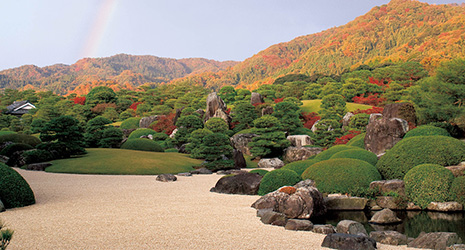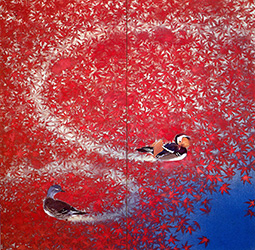INDEX
- English
- 日本語

The Dry Landscape Garden at the Adachi Museum of Art in autumn - English
- 日本語

Living Framed Painting, a “framed” view of the Dry Landscape Garden in autumn from inside the museum.

Passion by Kawabata Ryushi
September 2021
Appreciating Autumn Foliage Masterpieces and a Garden’s Autumn Colors

The Adachi Museum of Art in Yasugi City, Shimane Prefecture, famous for its beautiful Japanese-style gardens, houses a collection of Nihonga (Japanese-style painting) masterpieces depicting autumn leaves.

The Adachi Museum of Art in Yasugi City, Shimane Prefecture, is famous both in Japan and overseas for the beauty of its traditional Japanese landscape gardens. The grounds of the museum feature a variety of charming gardens that display vibrant red foliage in autumn, including the main Dry Landscape Garden that incorporates natural mountain scenes behind the garden.
The museum houses a large collection of Nihongai. A particular famous Nihonga painting in the museum’s collection is brought out every year for the special autumn exhibition. That work is Autumn Leaves, a byobu-e created by the master of Japanese painting (Nihonga) Yokoyama Taikan (1868–1958, hereinafter “Taikan”) in 1931. Byobu-e are paintings on folding screens, furnishings used to divide and decorate interior spaces. Autumn Leaves consists of a pair of six-panel folding screens, each approximately 1.6 meters high and 3.6 meters wide, depicting a resplendent maple tree, its boughs laden with autumn leaves and extending out across a backdrop of a river running with brilliant blue water.
“The piece has such youthful vigor that it’s hard to believe Taikan painted this work when he was over 60 years old,” says curator Kisa Fuyumi. “The use of intensely colored pigments and multiple shades to depict the maple leaves creates a three-dimensional effect. This is Taikan’s masterpiece, demonstrating his bold use of newly available materials, such as his use of platinum foil to portray the glittering surface of the river.”
In order to create the most aesthetically pleasing result when the screen is opened, Taikan’s composition deforms the maple leaves by horizontally elongating them slightly more than they appear on a real tree. The painting features a blend of light and dark colored autumn leaves arranged in superb harmony.

The Adachi Museum of Art’s collection of some 2,000 works comprises mainly Nihonga, and includes one of the best-known paintings by Kawabata Ryushi (1885–1966), a master of modern Nihonga who ranks alongside Taikan. That work is a byobu-e entitled Passion (Aizen) painted in 1934. Passion depicts a pair of mandarin ducks tracing circles as they paddle through water covered with fallen red-tinged maple leaves. The Japanese title “Aizen” means love between a man and a woman, and the surface of the water dyed red with autumn leaves is said to represent the surge of love. The expressions on the faces of the mandarin ducks and the trails formed by their movement on top of the leaves that float on the water are depicted realistically. At the same time, the composition is decorative, with autumn leaves painted in the same saturated tone—unlike Taikan’s Autumn Leaves—occupying most of the picture. The vibrancy of the leaves in their full autumnal glory is prominent in this work, leaving a lingering impression on the viewer.
Adachi Museum of Art founder Adachi Zenko (1899–1990) had an unwavering belief that “A garden is thought of as a living canvas.” A visit to the museum in autumn is a chance to appreciate the autumn foliage masterpieces on display along with the garden showing its autumn leaves.
* In the broad sense, Nihonga are paintings that employ traditional Japanese artistic techniques and materials. In the narrow sense, they are modern (late-nineteenth century until now) Japanese paintings that employ traditional Japanese artistic techniques with an awareness of Western paintings.


